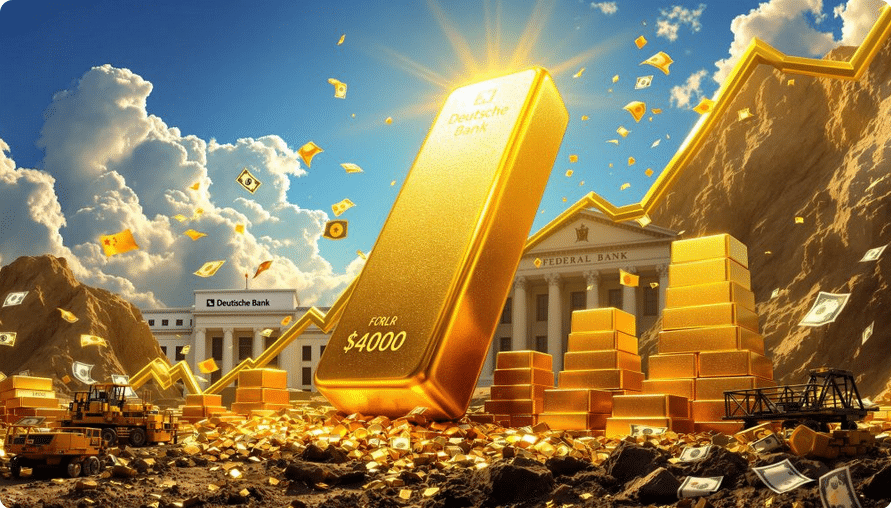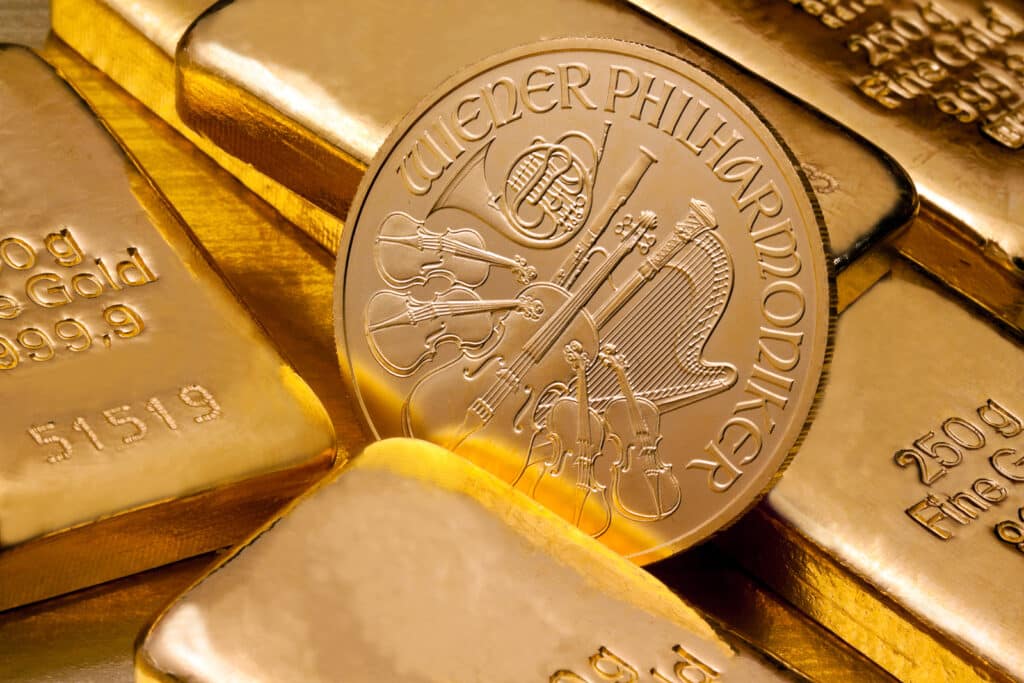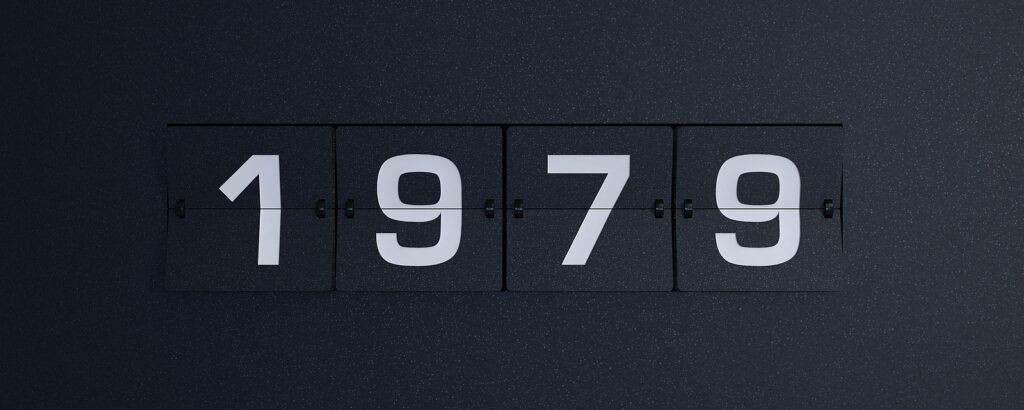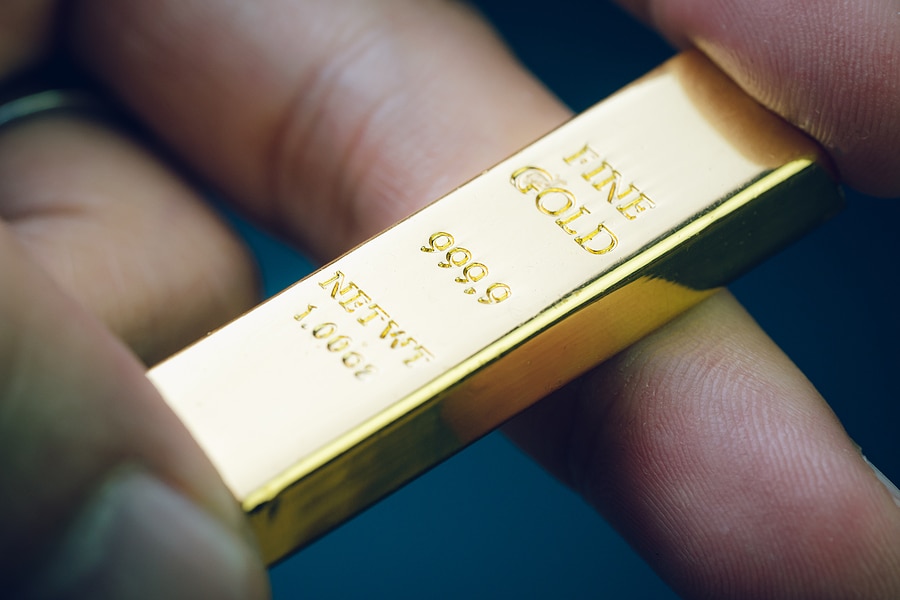Why Is Gold Hitting Record Highs in 2025?

Gold has been on a remarkable run in 2025, surging approximately 40% year-to-date and recently reaching an all-time high analysis of $3,702.95. This impressive performance has prompted Deutsche Bank to significantly revise its price outlook for the precious metal. But what factors are driving this bullish sentiment in the gold market?
Central Bank Purchasing Remains Robust
Central banks worldwide continue to accumulate gold at an extraordinary pace, with official demand running at twice the level of the 2011-2021 average. China has emerged as a particularly aggressive buyer, helping to sustain strong fundamental support for gold prices despite already elevated levels.
The ongoing central bank buying represents a significant shift in global monetary reserves management, with many nations seeking to diversify away from traditional foreign currency holdings.
Federal Reserve Policy Shifts Creating Tailwinds
Deutsche Bank analysts point to several monetary policy factors supporting their revised forecast:
- The Fed is expected to implement three rate cuts in 2025
- Potential additional easing in 2026 contrary to the Fed’s current projections
- Uncertainty surrounding changes in Federal Open Market Committee composition
- Ongoing challenges to Federal Reserve independence
These monetary policy dynamics typically benefit non-yielding assets like gold, which performs well in low-interest-rate environments.
Historically, gold has shown strong inverse correlation with real interest rates, making the anticipated Fed policy trajectory particularly supportive for bullion prices.
What’s Behind Deutsche Bank’s New $4,000 Gold Forecast?
Substantial Upgrade from Previous Projections
In a significant revision, Deutsche Bank has raised its 2026 gold price forecast by $300 to an average of $4,000 per ounce. This represents an 8.1% increase from their previous projection of $3,700 announced earlier in 2025.
The upgraded forecast follows multiple upward revisions from the bank over the past 18 months, reflecting the persistent strength in gold prices despite earlier expectations of a correction.
Supply Constraints Adding Support
The bank noted that recycled gold supply is currently running 4% below expected levels this year, which removes a potential ceiling on price appreciation. With limited new mine supply coming online and recycling activity subdued despite high prices, the supply-demand balance continues to favor higher prices.
Gold mining companies have been cautious about expanding production capacity following previous boom-bust cycles, resulting in relatively constrained new supply despite multiyear price increases.
US Dollar Weakness Expected
Deutsche Bank’s analysis suggests potential US dollar weakness ahead, which historically correlates with stronger gold prices. As the dollar potentially loses value against other major currencies, gold becomes more attractive as an alternative store of value.
The negative correlation between gold and the US dollar has been a consistent market pattern, with currency depreciation often coinciding with bullion appreciation.
What Risks Could Derail the Gold Rally?
Equity Market Competition
Strong performance in global equity markets could potentially divert investment flows away from gold. When stocks deliver robust returns, the opportunity cost of holding non-yielding assets like gold increases.
The historical relationship between gold and equities has been complex, with periods of both correlation and divergence depending on prevailing economic conditions and investor sentiment.
Seasonal Weakness Patterns
Deutsche Bank highlighted that gold has historically shown seasonal weakness during the fourth quarter, based on both 10-year and 20-year trend analysis. This cyclical pattern could create temporary headwinds for gold prices.
The seasonal pattern typically shows:
- Q1: Strong performance (January-March)
- Q2: Mixed performance (April-June)
- Q3: Relatively strong (July-September)
- Q4: Weaker performance (October-December)
Federal Reserve Policy Uncertainty
If US economic conditions remain resilient, the Federal Reserve might hold rates steady in 2026 rather than continuing to cut as markets currently anticipate. Such a scenario would likely be less supportive for gold prices than Deutsche Bank’s base case.
Recent economic indicators have been mixed, creating genuine uncertainty about the future path of monetary policy:
- Employment data shows continued resilience
- Inflation has moderated but remains above target in several categories
- Manufacturing activity has been inconsistent
- Consumer spending patterns show signs of normalization
How Are Other Precious Metals Affected?
Silver Forecast Also Upgraded
Alongside its gold revision, Deutsche Bank also raised its silver price forecast for 2026 to an average of $45 per ounce, up from its previous target of $40. This represents a 12.5% increase in the bank’s outlook for silver.
The bank’s silver upgrade is particularly notable as it represents a more aggressive percentage increase than the gold revision, suggesting expectations for potential outperformance in the industrial/precious metal.
Gold-Silver Ratio Implications
The revised forecasts imply a gold-to-silver ratio of approximately 88:1, suggesting Deutsche Bank expects gold to maintain its relative strength compared to silver, though with silver still posting significant gains.
Historically, the gold-silver ratio has averaged around 60:1 over the long term, indicating:
- Current projections still favor gold in relative terms
- Silver may have additional upside potential if the ratio reverts closer to historical averages
- Industrial demand recovery could further support silver prices
What Does This Mean for Investors?
Portfolio Allocation Considerations
With gold already up approximately 40% year-to-date in 2025 and potentially heading toward $4,000 per ounce, investors may need to reassess their precious metals allocation. Deutsche Bank’s forecast suggests additional upside potential despite already strong performance.
Investment strategies to consider include:
- Maintaining a strategic allocation to gold as a portfolio diversifier
- Potentially increasing exposure during seasonal weakness periods
- Balancing direct metal exposure with mining equities for different risk profiles
- Considering tax-efficient vehicles for precious metals exposure
Mining Company Investment Opportunities
Gold mining companies typically experience operating leverage to rising gold prices, potentially amplifying returns compared to the metal itself. As production costs remain relatively stable while gold prices rise, profit margins for well-positioned miners could expand significantly.
The mining sector presents several interesting dynamics in the current environment:
- Mid-tier producers often provide the best balance of growth and stability
- Royalty companies offer exposure to price increases with reduced operational risk
- Exploration companies offer higher risk/reward profiles but require careful due diligence
- Companies with production costs below $1,200/oz stand to benefit most from higher prices
Timing Entry Points
Given the seasonal patterns noted by Deutsche Bank, investors might consider whether fourth-quarter weakness could present more favorable entry points for establishing or adding to gold positions.
A strategic approach might include:
- Dollar-cost averaging into positions over time
- Increasing allocation during periods of price weakness
- Monitoring technical indicators for potential entry points
- Maintaining discipline regarding position sizing and portfolio balance
How Does This Forecast Compare to Historical Gold Performance?
Historical Context for $4,000 Gold
A $4,000 price target would represent a new paradigm for gold, which only crossed the $2,000 threshold relatively recently. When adjusted for inflation, however, gold’s 1980 peak would equate to approximately $3,500 in today’s dollars, suggesting the metal is entering historically significant territory.
The progression of gold’s major price milestones shows the acceleration in recent years:
- $500/oz first reached: December 1979
- $1,000/oz first reached: March 2008
- $2,000/oz first reached: August 2020
- $3,000/oz first reached: March 2025
- $4,000/oz projected: 2026
Recent Price Acceleration
Gold’s price appreciation has accelerated notably in 2025, with the metal gaining approximately 40% year-to-date. This rapid ascent follows years of consolidation and suggests a potential regime change in how investors value the precious metal.
The current rally has been characterized by:
- Steady upward momentum with limited pullbacks
- Broad participation across investor categories
- Support from both investment and central bank demand
- Muted response to traditional headwinds like rising interest rates
What Broader Economic Signals Does This Send?
Inflation Expectations
Gold’s strong performance and bullish forecasts may reflect persistent concerns about long-term inflation despite central bank efforts to control price increases. The metal has historically served as a record highs & inflation hedge during periods of currency debasement.
Current economic indicators present a mixed picture:
- Official inflation metrics have moderated from 2022-2023 peaks
- Core services inflation remains sticky in many economies
- Money supply growth has slowed but remains elevated by historical standards
- Labor market strength continues to support wage growth
Geopolitical Risk Premium
Rising gold prices often incorporate a premium for geopolitical uncertainty. Deutsche Bank’s elevated forecast may partially reflect expectations for continued or increased global tensions through 2026.
Gold tends to perform well during periods of:
- Regional conflicts and geopolitical instability
- Trade tensions between major economies
- Elections and political transitions
- Regulatory uncertainty affecting traditional assets
Monetary System Evolution
Central banks’ aggressive gold purchasing, particularly from nations seeking to reduce dollar dependence, signals ongoing evolution in the global monetary system. Deutsche Bank’s gold price forecast suggests this trend will continue to support gold prices.
Recent developments include:
- BRICS nations discussing alternatives to dollar-based trade
- Central bank digital currency development accelerating globally
- Growing calls for monetary system reform from various nations
- Increased scrutiny of reserve currency status and implications
Read the full article HERE.


